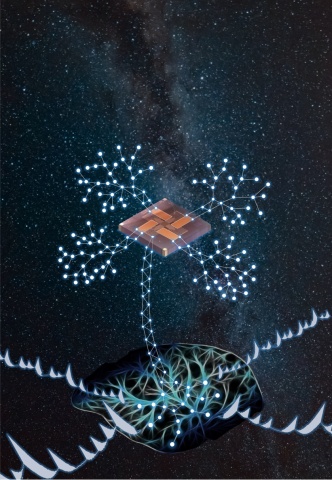
Our chair has published a groundbreaking paper on neuromorphic computing. In the article published in the renowned journal Nature Electronics (Intrinsic plasticity of silicon nanowire neurotransistors for dynamic memory and learning functions), we show how transistors made of nanowires can imitate important functions of the human brain, dynamic storage and learning. The work was developed in close cooperation with scientists from the Helmholtz Center Dresden-Rossendorf, from Beijing, from Calcutta, from Pohang and from Berkeley.
"One of the declared goals of research in the field of neuromorphic computing is to map the self-organizing and self-regulating nature of the brain in circuits as well as in materials - hence the term neuromorphic, " says Prof. Gianaurelio Cuniberti, who coordinated the work. The resulting computers should be able to adapt and optimize their performance and tasks during operation according to the requirements and should be able to solve problems for which they were not originally programmed. They are constantly learning and have the so-called plasticity of a biological nervous system. Plasticity refers to the ability to change the structure and function of the electronic circuit in order to adapt ongoing processes to the needs of the user - in other words, to realign and rebuild the electronic circuit from its individual switching elements if necessary.
A further advantage of neuromorphic computers is their basic structure. In the human brain, information is stored and processed at the same location, simultaneously and in parallel via a complex network of synaptic connections between more than one hundred billion neurons. This distinguishes the brain fundamentally from today's computers. They function according to the von Neumann principle, in which the two elementary functions of storage and computing are performed in separate units. The additional connections required between memory and computing unit limit the ability to solve complex problems flexibly and cause enormous energy and material consumption.
Neuromorphic computer architectures, on the other hand, as made possible by our discovery, aim to go well beyond von Neumann computers. They combine the storage and processing of information within a functional unit that is capable of learning - in this specific case, an elaborately constructed silicon nanowire transistor with a sol-gel coating that provides plasticity modelled on neurons. This allows powerful, fast and flexible brain-inspired algorithms, such as those required for artificial intelligence, to be executed at the hardware level. "Thanks to the work of the research team, this long-standing vision has come a great deal closer, " concludes Cuniberti.



Our chair has published a groundbreaking paper on neuromorphic computing. In the article published in the renowned journal Nature Electronics (Intrinsic plasticity of silicon nanowire neurotransistors for dynamic memory and learning functions), we show how transistors made of nanowires can imitate important functions of the human brain, dynamic storage and learning. The work was developed in close cooperation with scientists from the Helmholtz Center Dresden-Rossendorf, from Beijing, from Calcutta, from Pohang and from Berkeley.
"One of the declared goals of research in the field of neuromorphic computing is to map the self-organizing and self-regulating nature of the brain in circuits as well as in materials - hence the term neuromorphic, " says Prof. Gianaurelio Cuniberti, who coordinated the work. The resulting computers should be able to adapt and optimize their performance and tasks during operation according to the requirements and should be able to solve problems for which they were not originally programmed. They are constantly learning and have the so-called plasticity of a biological nervous system. Plasticity refers to the ability to change the structure and function of the electronic circuit in order to adapt ongoing processes to the needs of the user - in other words, to realign and rebuild the electronic circuit from its individual switching elements if necessary.
A further advantage of neuromorphic computers is their basic structure. In the human brain, information is stored and processed at the same location, simultaneously and in parallel via a complex network of synaptic connections between more than one hundred billion neurons. This distinguishes the brain fundamentally from today's computers. They function according to the von Neumann principle, in which the two elementary functions of storage and computing are performed in separate units. The additional connections required between memory and computing unit limit the ability to solve complex problems flexibly and cause enormous energy and material consumption.
Neuromorphic computer architectures, on the other hand, as made possible by our discovery, aim to go well beyond von Neumann computers. They combine the storage and processing of information within a functional unit that is capable of learning - in this specific case, an elaborately constructed silicon nanowire transistor with a sol-gel coating that provides plasticity modelled on neurons. This allows powerful, fast and flexible brain-inspired algorithms, such as those required for artificial intelligence, to be executed at the hardware level. "Thanks to the work of the research team, this long-standing vision has come a great deal closer, " concludes Cuniberti.

